
Fred Rowe
Sierra Bright Dot Fly FIshing Report 06-03-2022
When the wind is not blowing fly fishers off the water the fly fishing in the Eastern Sierra has been good. The cutthroat spawn in the Crowley Lake tributaries has come to an end. Hatches of mayflies, stoneflies, and caddis flies are beginning. The days are warming as we head towards summer solstice. Nymphing is providing the bulk of the action, but it will not be long that dry flies dominate the Eastern Sierra fly fishing scene.
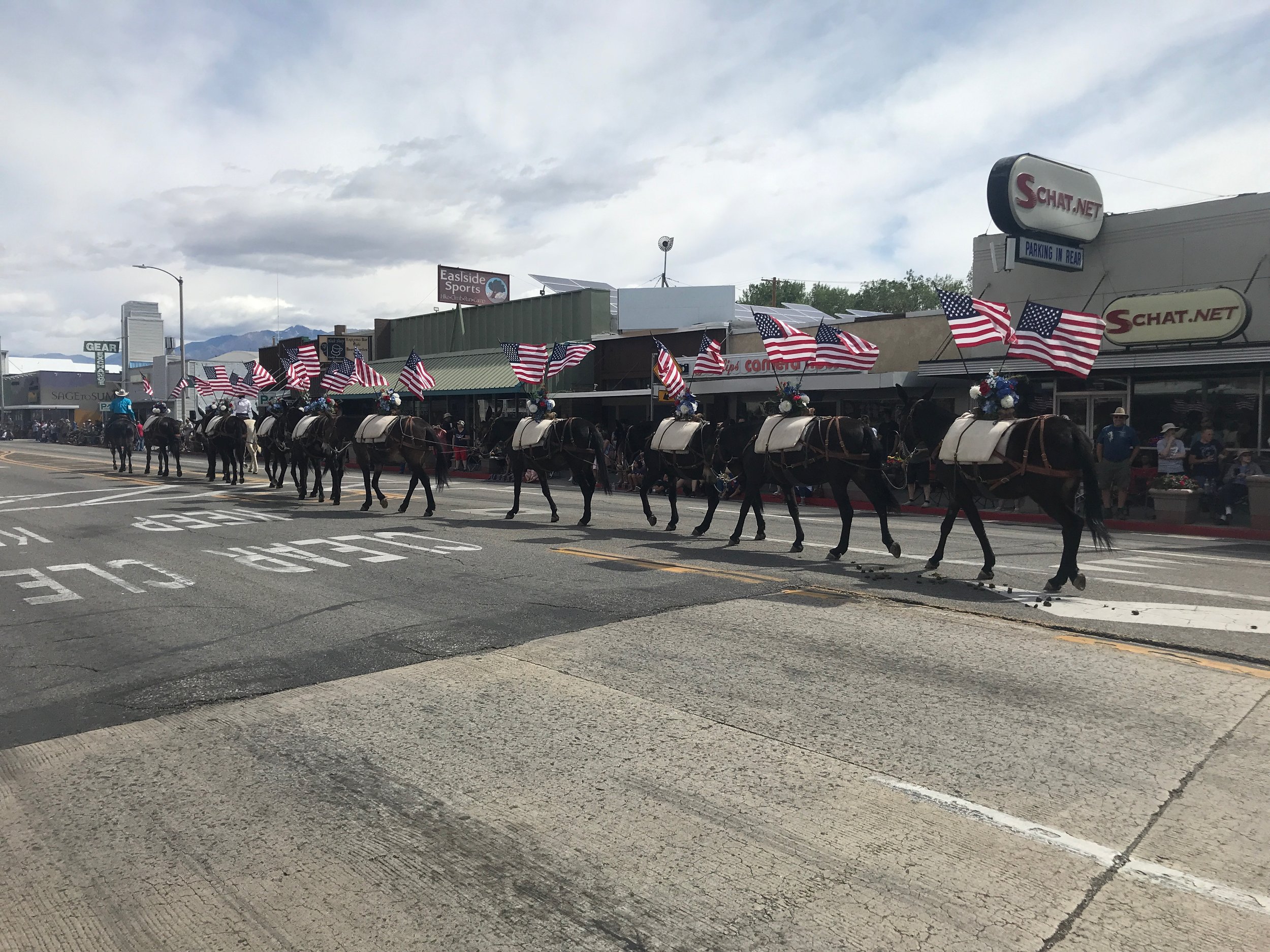
Bishop Mules days parade was back and the streets were lined with a great crowd.
Lower Owens River:
Wild Trout Section:
The lower Owens River is coming up and flows at the time of this posting are up to 230 CFS. Flows of 300 CFS is at the top limit of being able to wade the river. With Eastern Sierra streams opening up the fly fishing pressure on the lower Owens River has dissipated. There are hatches of blue wing olive mayflies, pale morning dun mayflies, little yellow stoneflies, and caddis flies, but the trout have not been coming to the surface consistently to feed on the hatching insects. Nymphing, primarily Euro nymphing, has been the most productive method of fly fishing the river. I’m using olive quilldigons, hot spot pheasant tail nymphs, Frenchie’s, stoner nymphs, bead head flash back pheasant tail nymphs, and bead head flash back gold ribbed hare’s ears. The key is to get the nymphs down on the substrate where the trout are feeding.
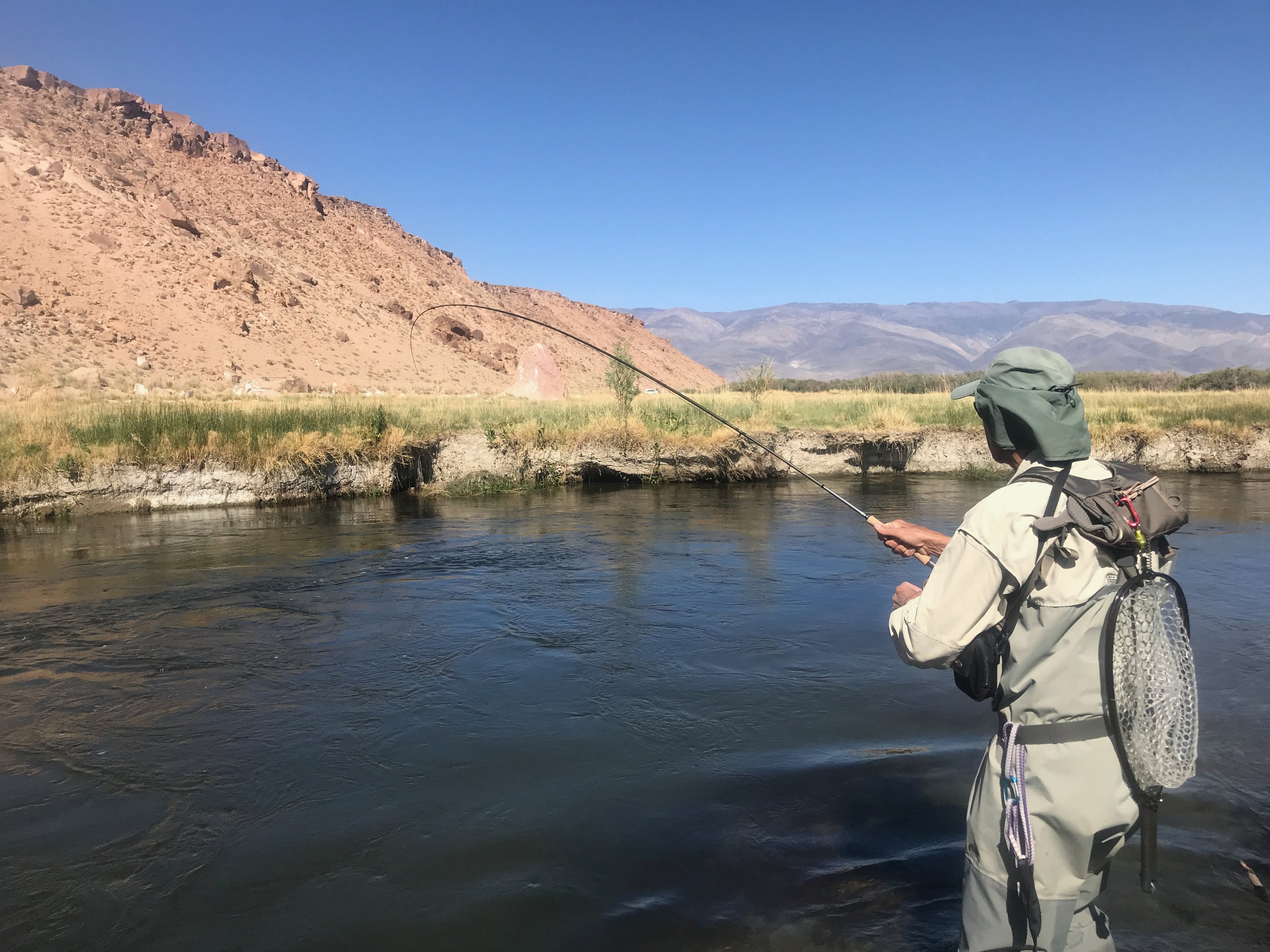
Euro nymphing is the most productive way to fly fish the wild trout section of the Owens River right now.
Hot Creek:
Interpretive Site:
With hatches still sporadic fly fishing in the interpretive site is tough. Nymphing with bead head flash back pheasant tail nymphs, bead head flash back gold ribbed hare’s ears, midges nymphs and pupae in tiger and zebra coloration, and scuds under a dry fly is producing a few trout. The insects are active from about 10:00 to 2:00 P.M. As summer approaches the insect hatches will intensify and the dry fly action will improve.
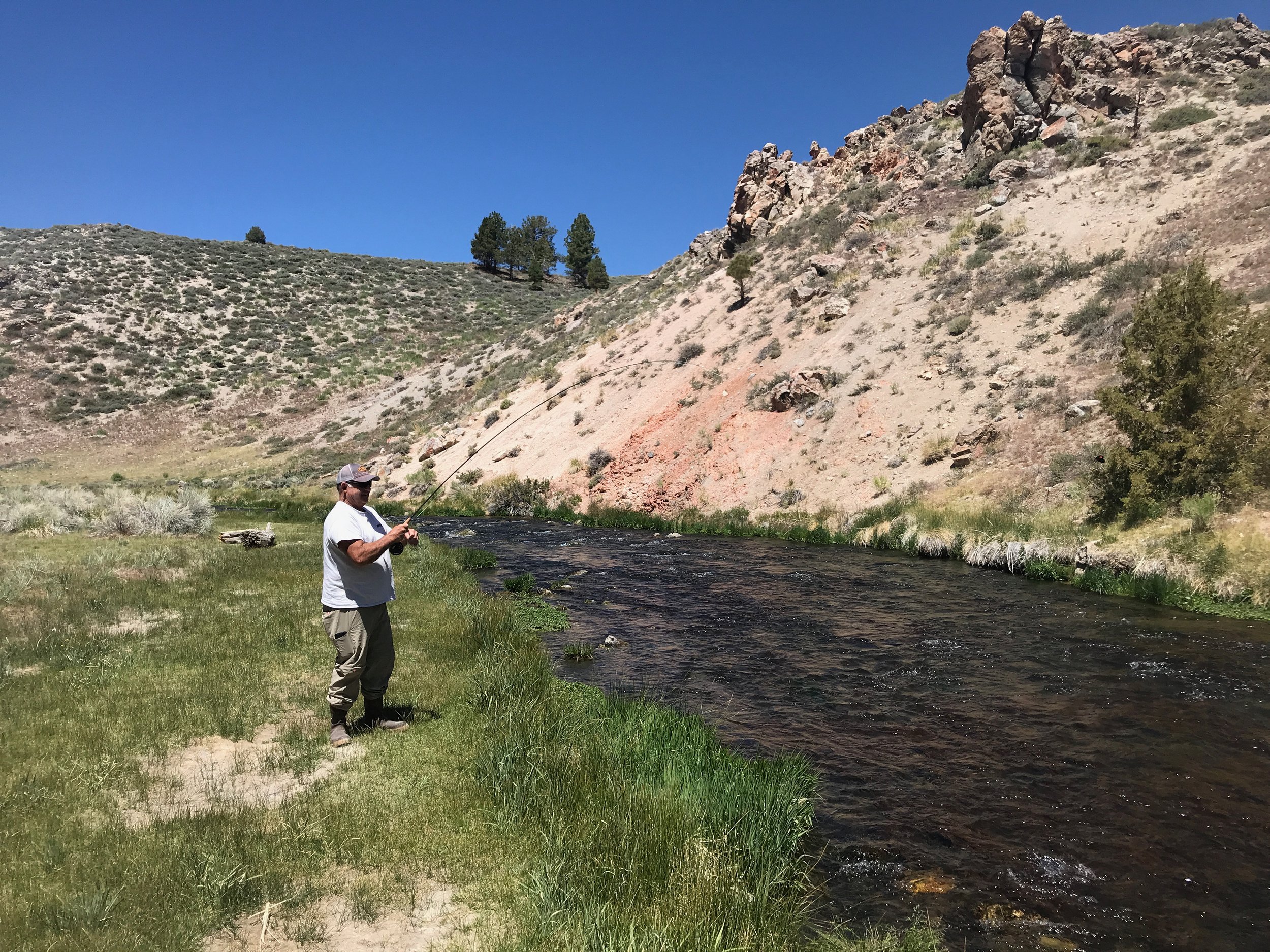
Erik Skasick from Brea hooked up to a wild rainbow trout in the canyon section of Hot Creek fishing with a size 18 bead head flash back pheasant tail nymph.
Hot Creek:
Canyon Section:
The increased gradient in the canyon section of Hot Creek means the trout have to react to the fly patterns quickly unlike the interpretive site where the fish can scrutinize the fly patterns. This makes catching the trout in the canyon section easier. Bead head flash back pheasant tail nymphs in size 18, and bead head flash back gold ribbed hare’s ears in size 16, olive burlap caddis in size 14, size 18 cream or gray caddis pupae, and olive scuds in size 12 are fooling wild rainbows and browns. I’m fishing the nymphs under a size 16 Adams parachute, size 12 Chernobyl ant, or size 12 Morrish hopper.
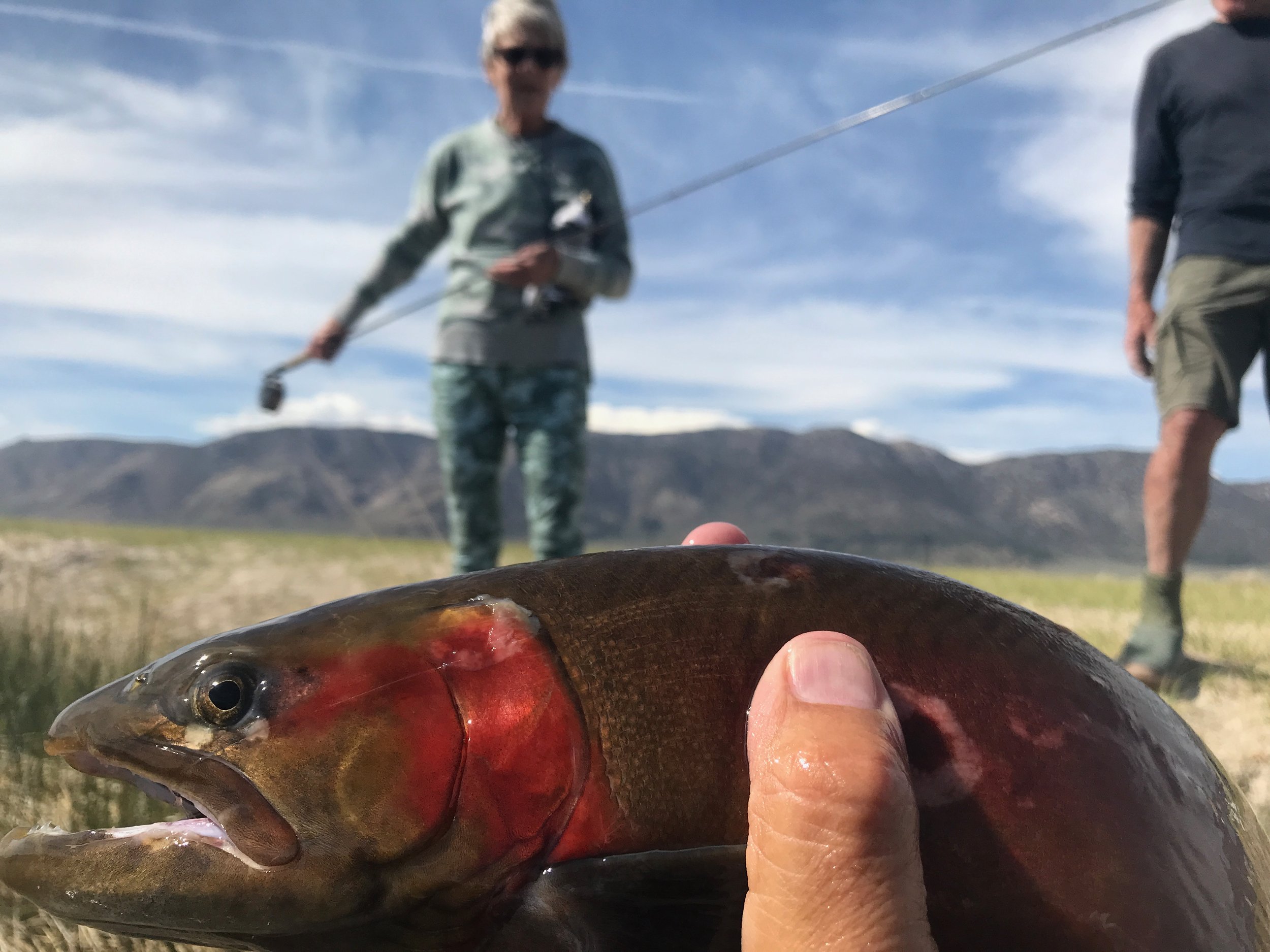
This is the last cutthroat of the season for me in a season that saw lots of cutthroats in the upper Owens River.
Upper Owens River:
Above Benton Crossing Bridge:
The cutthroat spawn is coming to an end. Most of the spawners have returned to the lake or died due to the rigors of spawning. Resident trout and juvenile trout will provide the action for fly fishers until Fall when the spawning browns return. Pale morning dun mayflies will be the first hatch to show up and should be hatching in the next week or two. Grass hoppers will be next along with caddis.
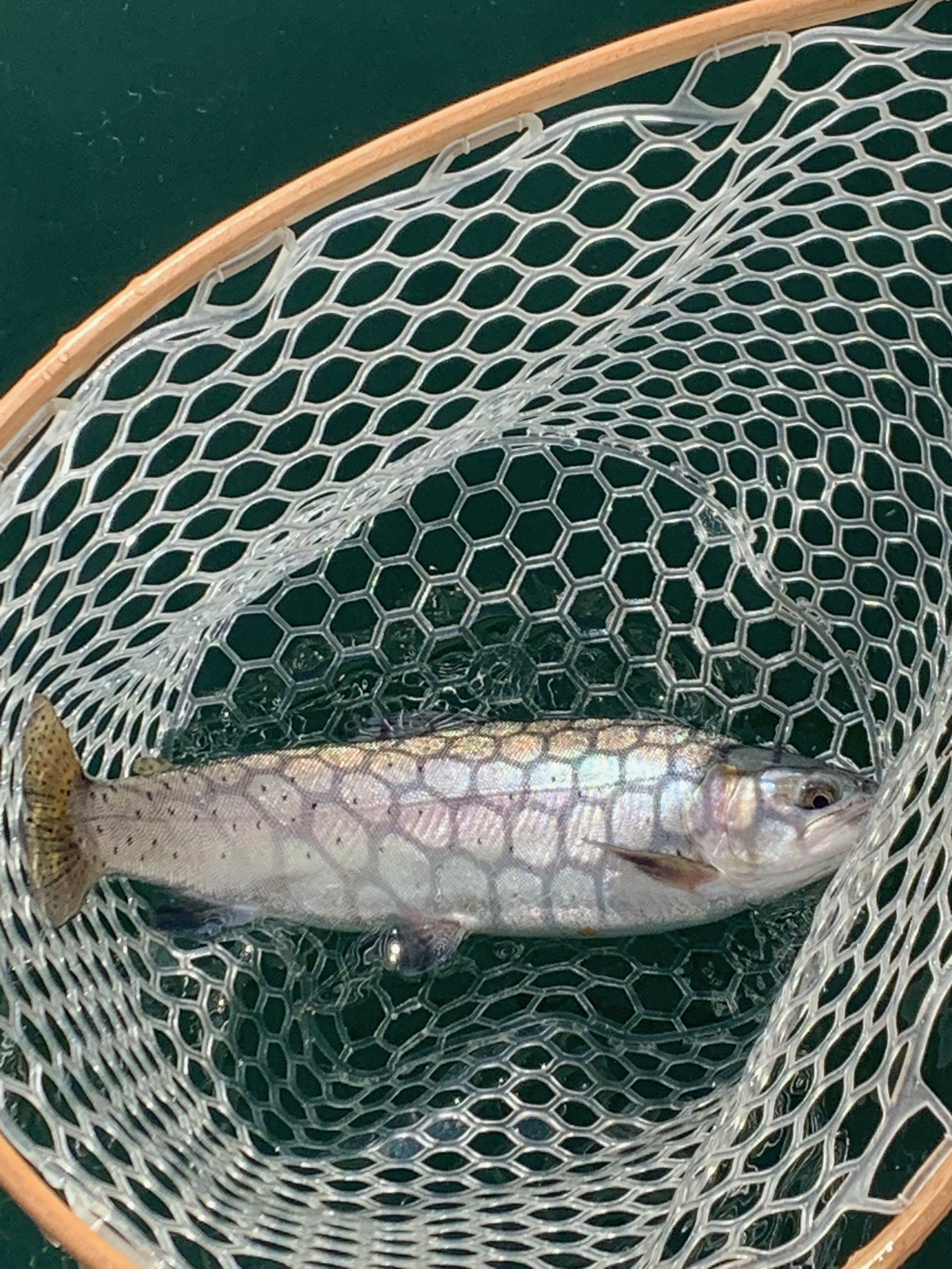
A chunky 16 inch cutthroat that took a tiger midge fished 18 inches off the bottom in McGee Bay on Crowley Lake.
Crowley Lake:
When the wind is not blowing the boats of the lake midge fly fishing has been good in McGee Bay on the northwest side, Sandy Point, Six Bays, and North Landing. The fish have moved out into deeper water from 15 to 25 feet. Midges in gray, tiger, zebra, and Albino Barons are producing the trout. Windless afternoons have been producing trout for the few fly fishers that explore the lake after the morning bite. One of the keys to success on the lake is to vary the depth of your midge. I fish my midges from three inches to four feet of the bottom.
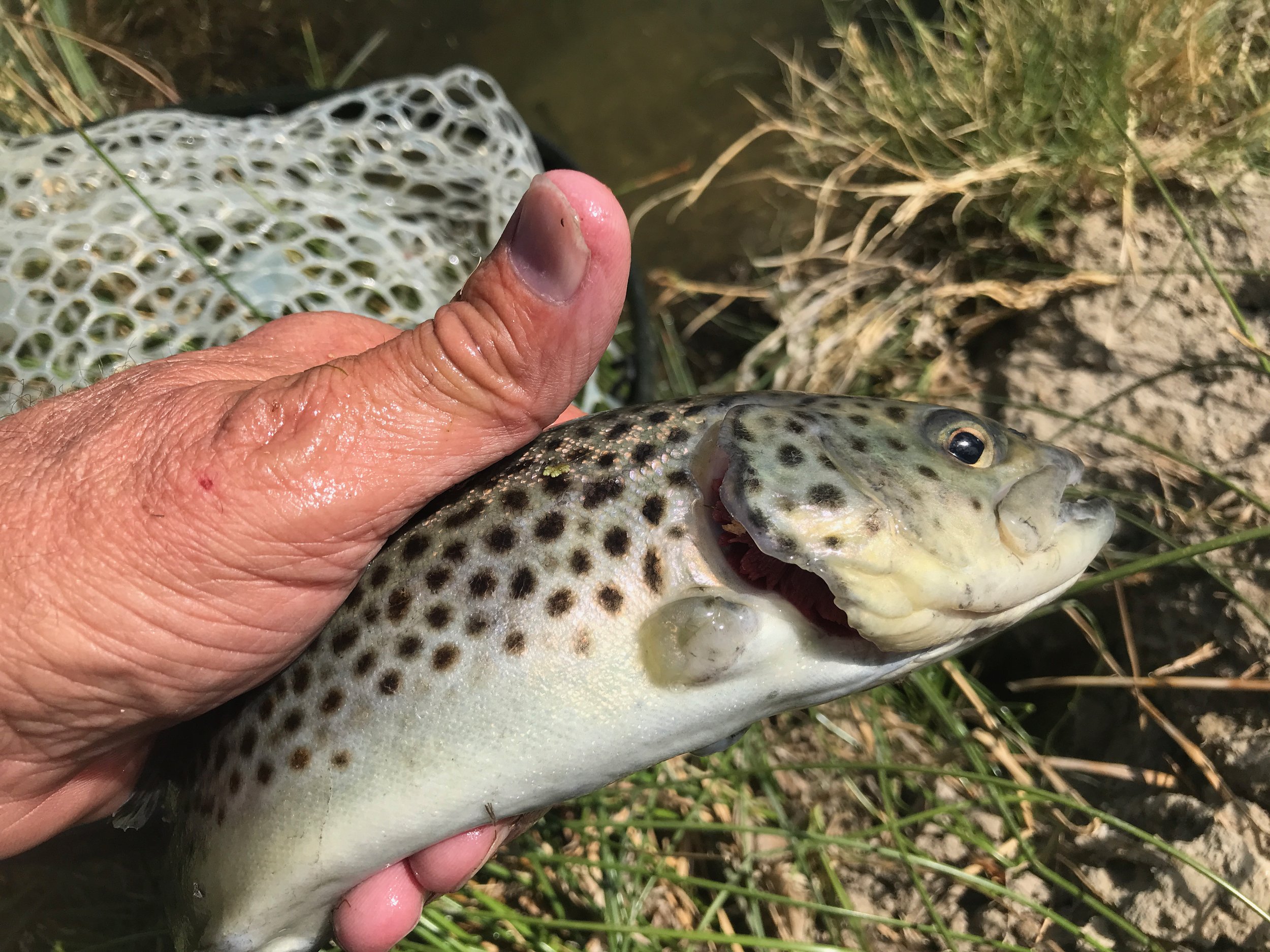
This brown trout caught in Bishop Creek Canal has its pectoral fins clipped showing that it is a stocked trout.
Bishop Creek Canal:
Behind the Ford Dealer:
Nymphing under an indicator with size 18 bead head flash back pheasant tail nymphs, and size 16 bead head flash back gold ribbed hare’s ears is fooling wild and stocked brown trout. I like to fish the faster water sections of the canal below the Los Angeles Department of Water and Power weirs. These oxygenated sections have a good concentration of trout. You need to get a good drag free drift to fool the wild trout.
Sierra Bright Dot Fly Fishing Report 05-27-2022
Wind continues to hamper Eastern Sierra fly fishing opportunities. I have had mornings blown out that have turned into a great afternoon. I have had great mornings where the wind has blown out the afternoon fly fishing opportunities. For the Owens Valley Memorial weekend is Mule days. The mule days people are here in full capacity. Lots of events taking place at the Tri County Fair Grounds this weekend. Hatches are just getting started. June is the biggest month of hatching aquatic insects. Look for hatches of pale morning dun mayflies, blue wing olive mayflies, caddis flies, and little yellow stone flies. Summer is starting and so is the heat!
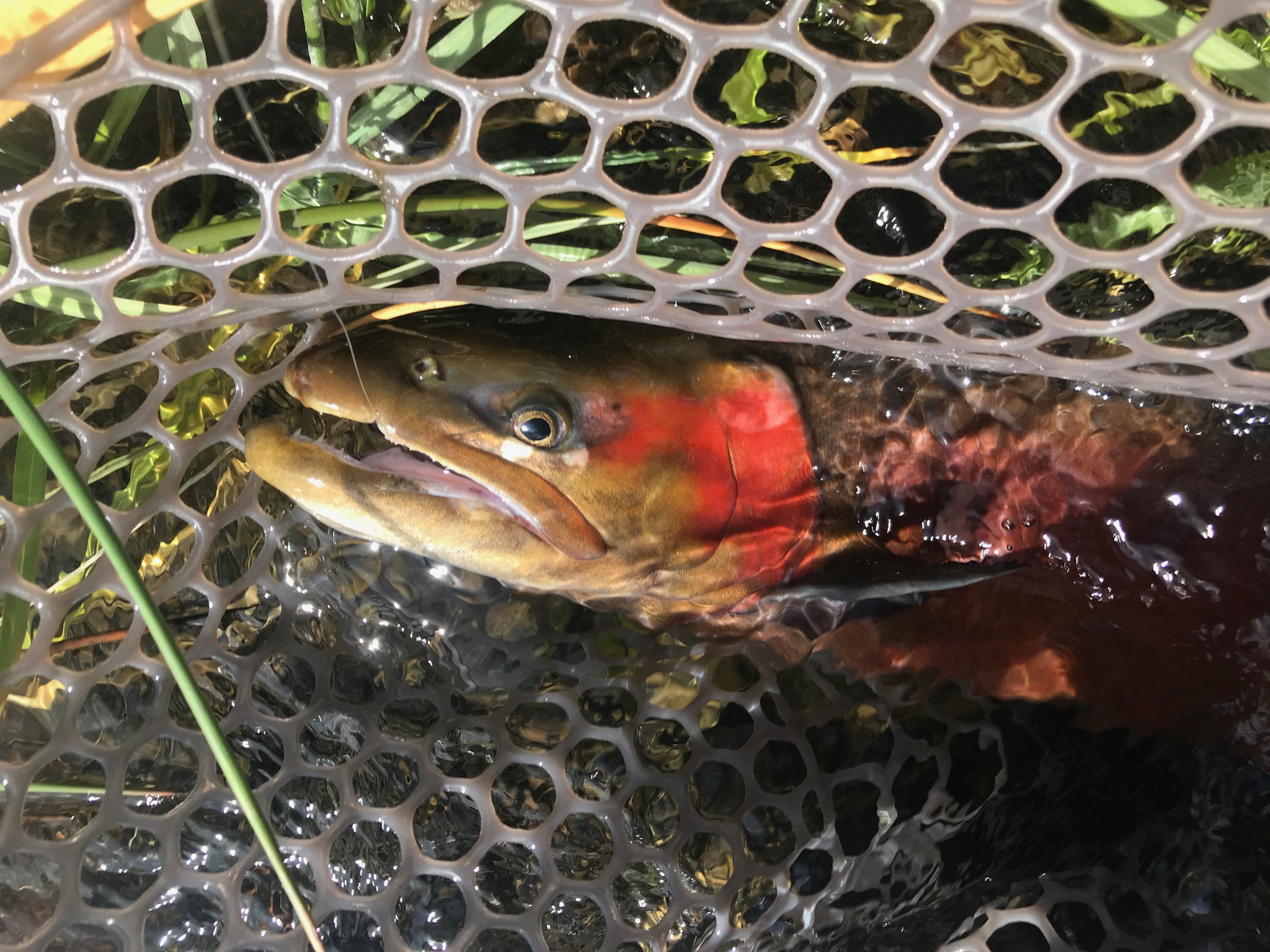
The cutthroat run has been good, but is coming to an end in the next week or two.
Lower Owens River:
Wild Trout Section:
Euro nymphing continues to be the most productive method of fishing the wild trout section of the lower Owens River. Pale morning dun mayflies, little yellow stones, and caddis are hatching. The trout are not coming to the surface to feed on these hatching insects. Nymphing is the best way to fool a trout right now with stoner nymphs, caddis nymphs, caddis emergers, and bead head flash back pheasant tail nymphs. Look for a size 20 blue wing olive mayfly hatch first thing in the morning. It has been done by 9:30 A.M.
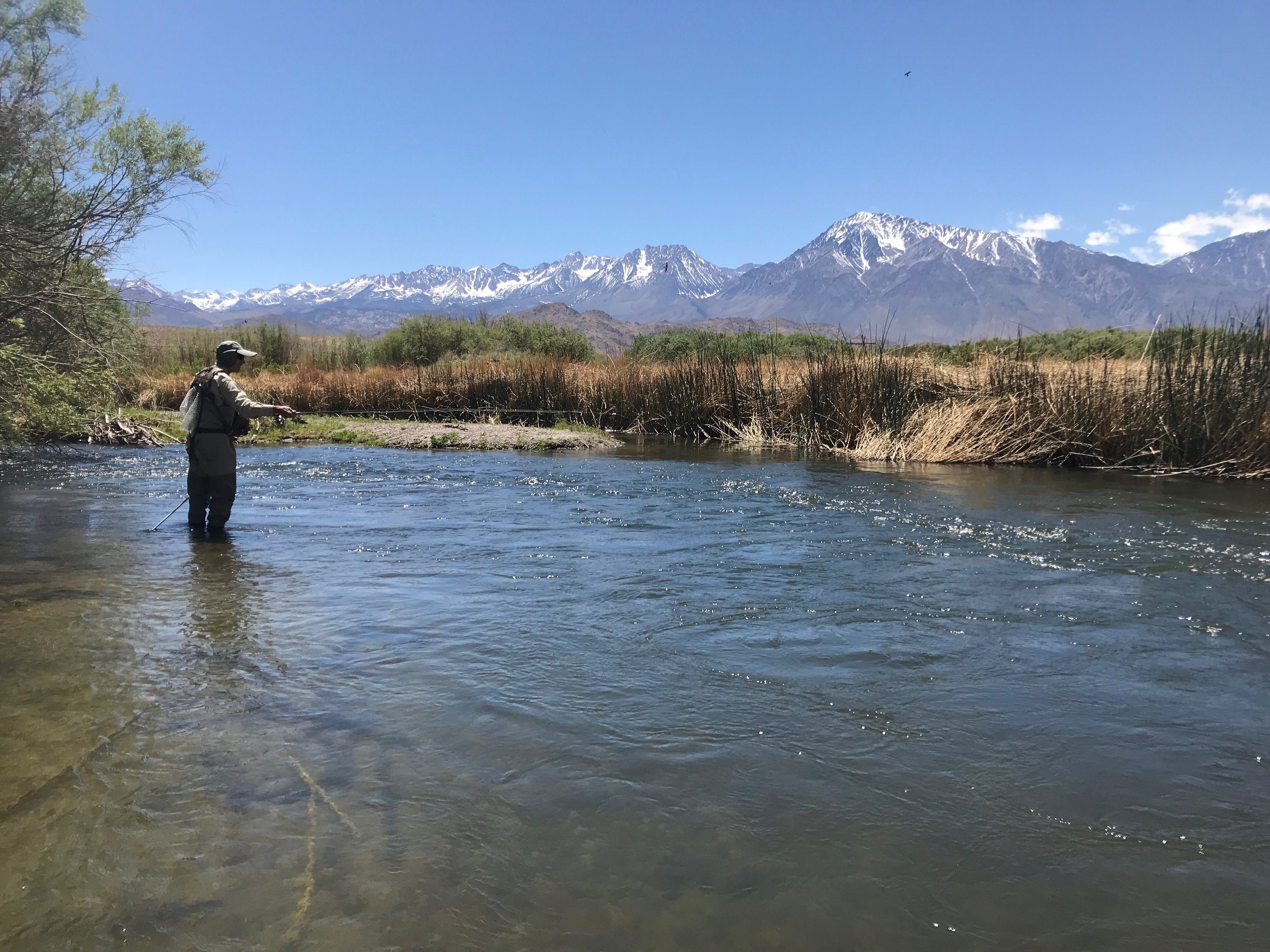
Euro nymphing the pools below a riffle is producing wild brown trout to 14 inches on the wild trout section of the Owens River.
Hot Creek:
Interpretive Site:
Fishing is tough at the interpretive site as there are not a lot of insects hatching. There are a few caddis and a few blue wing olive mayflies hatching. A few trout are feeding on these hatching adults, but the majority of trout are feeding on nymphs in the bottoms of the deeper holes. Gray caddis nymphs, olive scuds, and bead head flash back pheasant tail nymphs are producing a few trout. Windy days makes it hard to cast and hard to get a drag free drift. The creek fishes best on windless days!
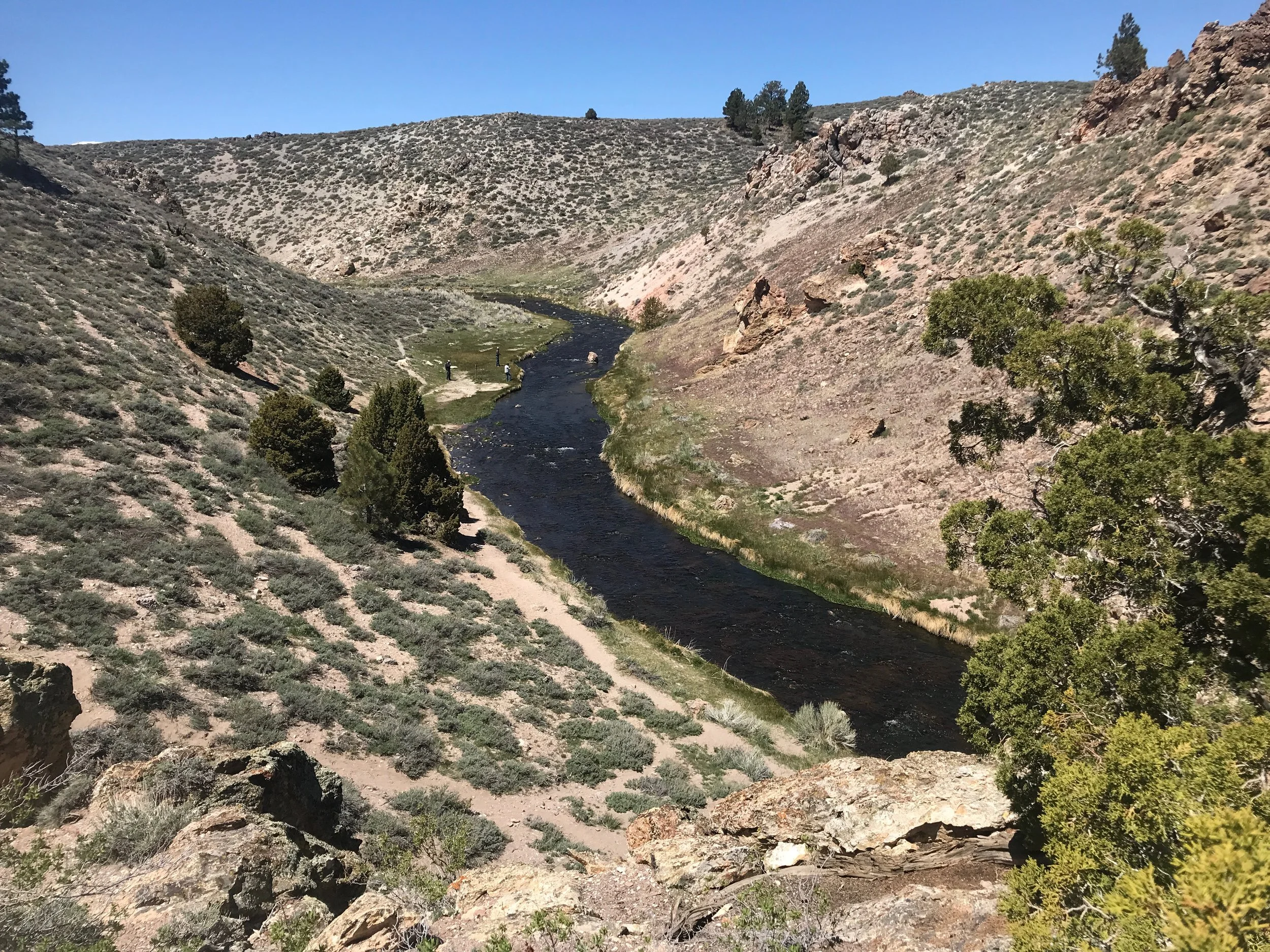
The steeper gradient of Hot Creek Canyon makes it ideal for fishing nymphs like a size 20 bead head flash back pheasant tail nymph.
Hot Creek:
Canyon Section:
This is your best bet for catching trout in Hot Creek right now. Nymphing under a dry fly is the best way to go. I’m using Chernobyl ants, Adams parachutes, and hoppers for the dry fly. Twenty four to 36 inches of 5X fluorocarbon tippet tied to the hook of the dry fly with a bead head flash back pheasant tail nymph in size 20, an olive scud in size 12, and a gray caddis emerger in size 20 are fooling the trout. I’m done fishing Hot Creek by 2:00 in the afternoon and am off looking for lunch or another fly fishing spot. If the winds not up I’m heading to the upper Owens.
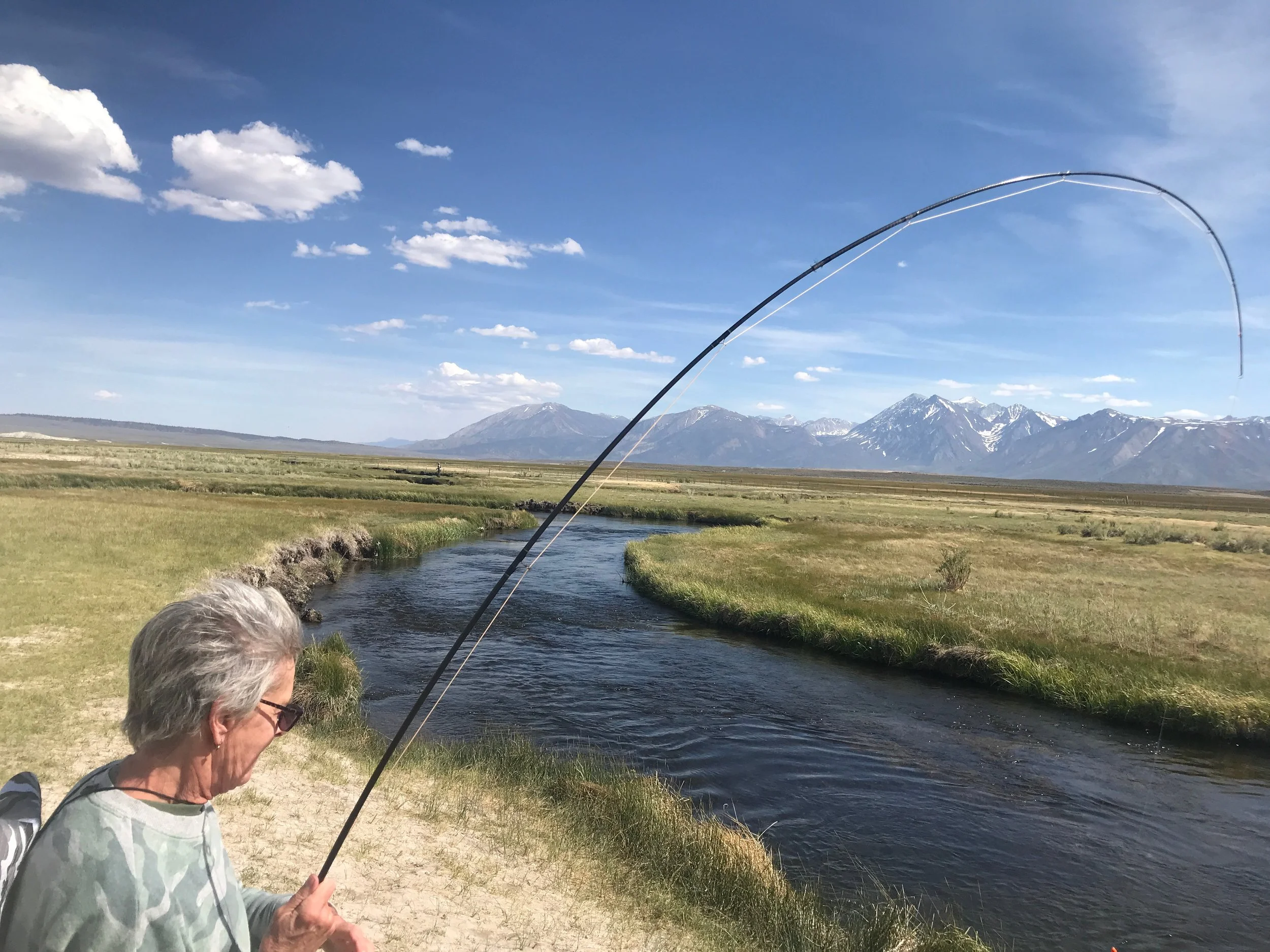
First time fly fishers Lori Tardiff from Oceanside hooked up to a cutthroat on the upper Owens River in the afternoon wind.
Upper Owens River:
Above Benton Crossing Bridge:
The cutthroat spawn is in full swing with a lot of the fish showing signs of the rigors of spawning. A lot of the fish have white spots on them which is caused from rubbing against the rocky bottom to make redds. A high percentage of the spawning cutthroats do not make it back to the lake. I’m continuing to fish the deep holes, runs and cutbanks for the resting-feeding trout. I’m not targeting the spawning fish on redds. The fish are taking size 12 stoner nymphs, size 12 green/gold Prince nymphs, and size 12 bead head flash back gold ribbed hare’s ears.
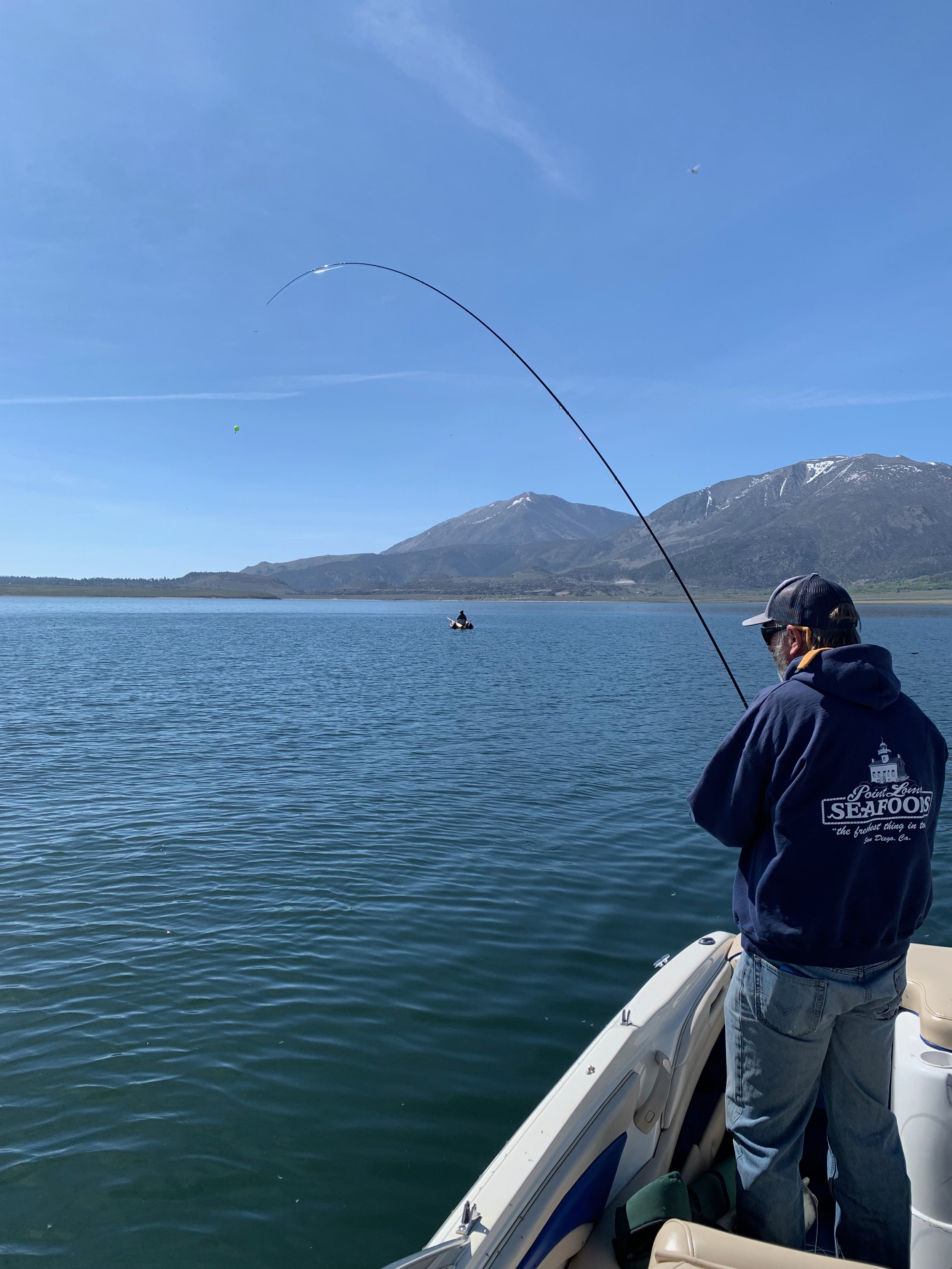
Hooked up with a tiger midges in the north corner of McGee Bay in 15 feet of water on a cold windy morning.
Crowley Lake:
Wind is the issue on the lake. Some mornings are windy and some afternoons are windy. You just have to hit the right time on the lake. The north side of McGee Bay, Sandy Point, Sometimes Bay, and Crooked Creek Arm are productive spots. The guide boats are moving around trying to find spots with lots of fish taking the midges. Albino Barons, grey midges, tiger midges, and zebra midges fished in 14 to 17 feet of water are fooling rainbows, browns, and cutthroats. I’m fishing my flies 12 to 18 inches of the bottom.

When the winds not blowing the canal has a size 20 blue wing olive hatch happening early in the morning.
Bishop Creek Canal:
Behind the Ford Dealer:
For those that can get out to the water early the blue wing olive hatch has been good for an hour or an hour and half starting at 8:30 A.M. I’m using a size 20 blue wing olive parachute. Once the hatch is over, I’m fishing an indicator with a size 16 bead head flash back gold ribbed hare’s ear, or a size 18 or 20 bead head flash back pheasant tail nymph. This area is prone to afternoon winds.
Discover more from Sierra Wave: Eastern Sierra News - The Community's News
Subscribe to get the latest posts sent to your email.


















